A bog or wetland filter is the most effective pond filter there is.
In this article I will explain exactly how big or small to make your bog filter. I will also show my favourite design for a bog or wetland filter.
If you want to build a pond on a budget and utilise a bog filter, you might find my downloadable pdf that contains all the formulas I use when I construct my ponds.
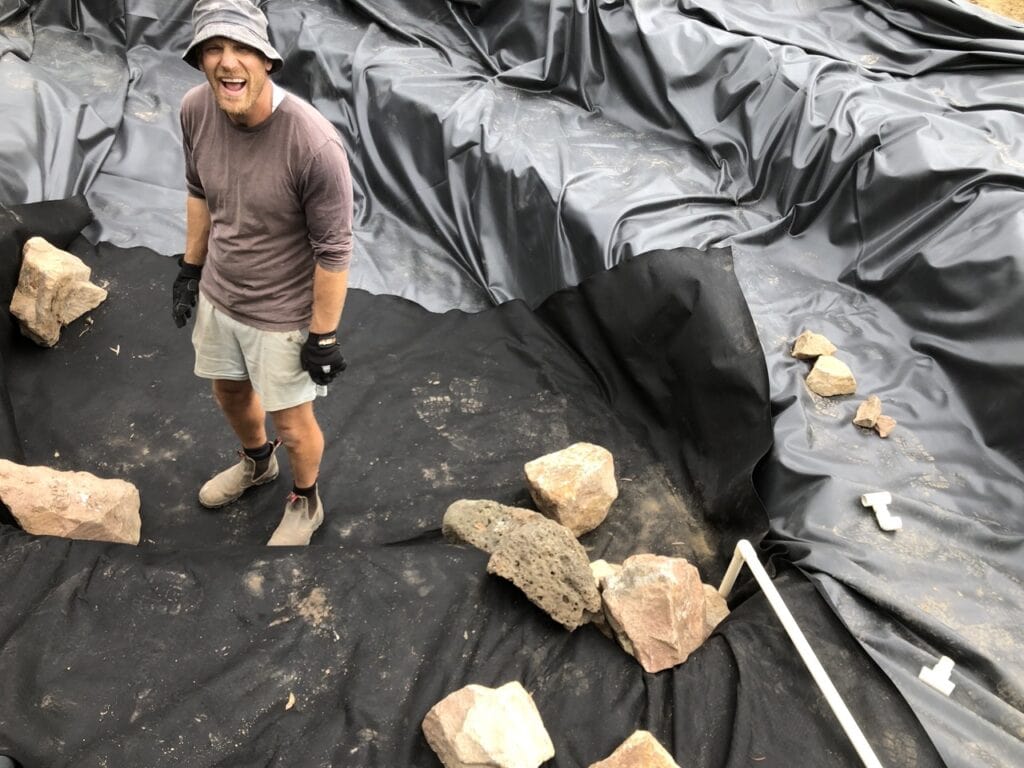
Blueprint I use to build my ponds
- All the numbers I use to design my ponds, delivered straight to your inbox
- These formulas have helped people all over the world build beautiful, low maintenance ponds, without spending a fortune.
- Access to a private community of like minded people and a chat bot that loves answering pond related questions.
The actual size is going to depend on what the ponds main function is.
Ponds require different sized filters for different reasons.
A Fish pond requires a filter that will process the ammonia the fish produce to keep the water fish safe. This is known as the nitrogen cycle (click the link to read my article on the nitrogen cycle).
A wildlife pond doesn’t have many fish in it if any. Wildlife ponds such as a frog pond wont even need a super filter.
In this situation the pond itself is the filter. Provided it has a nice balance of plants and surface area for good bacteria.
A water garden pond fits into the same category as a wildlife pond the amount of waste needing processing is so minimal a filter like a bog or wetland is totally unnecessary.
Next we have swim or recreation ponds. Because these ponds are going to have people swimming and frolicking in them the water quality needs to be pristine!
So let’s first look at the size of a bog filter for a fish pond.
Bog filter size for a fish pond
The size of a bog filter for a fish pond should be between 10-15% of the area or volume of the pond.
For small containerised ponds I like to use the volume measurement.
Volume is very easy to calculate on small ponds. More often than not the volume will be stated on the container or preformed pond.
So as an example this is one of my wine barrel ponds. The pond itself is a half wine barrel. This holds about 100 litres (26 Gal) of water.
I purchased a 20L (5 gal) container to create the bog. Its a little oversized if you look at the numbers, but keep in mind it isn’t filled completely to the top.
So once it’s all said and done it would be right around the 15% mark.
On larger, irregular shaped ponds using surface area to calculate the size of the bog filter is easier.
If you are unsure how to calculate the area or volume of a pond check out my article on calculating pond volume/area.
So if we use surface area to calculate the bog size, we are still aiming for 10-15%
As an example a pond with a 40m2 surface area would have a bog of 4-6m2.
On these larger in-ground i like to have the bog and pond seperate and connected by a stream.
The pump sends water up to the bog filter and then it is returned via gravity back into the pond.
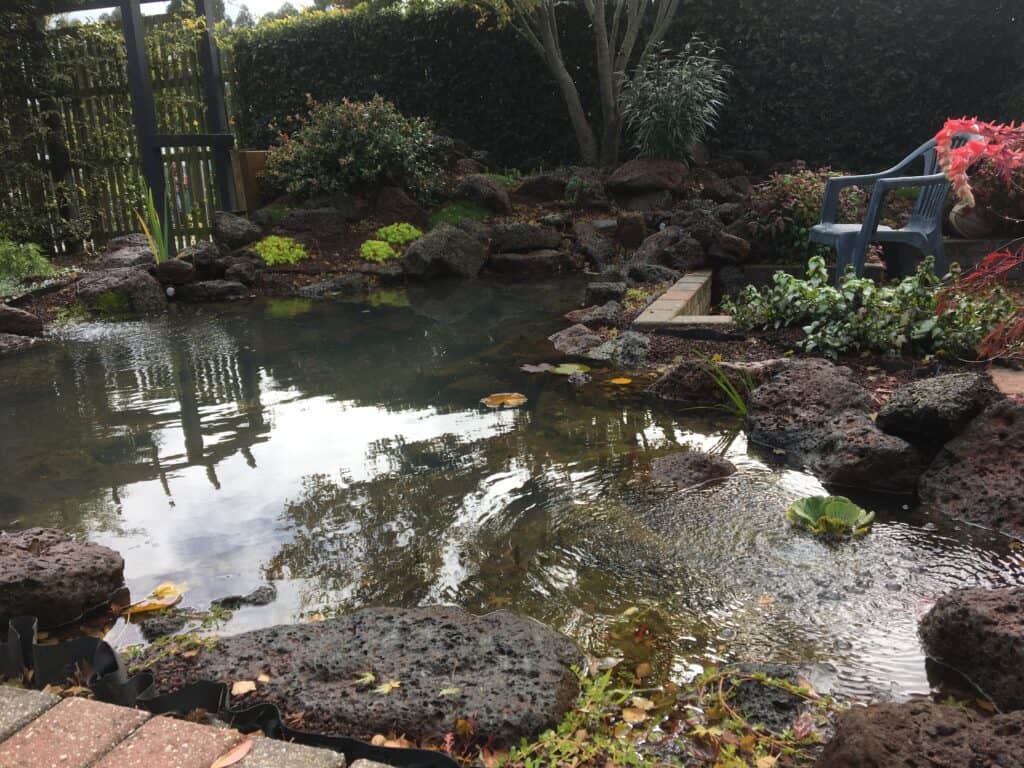
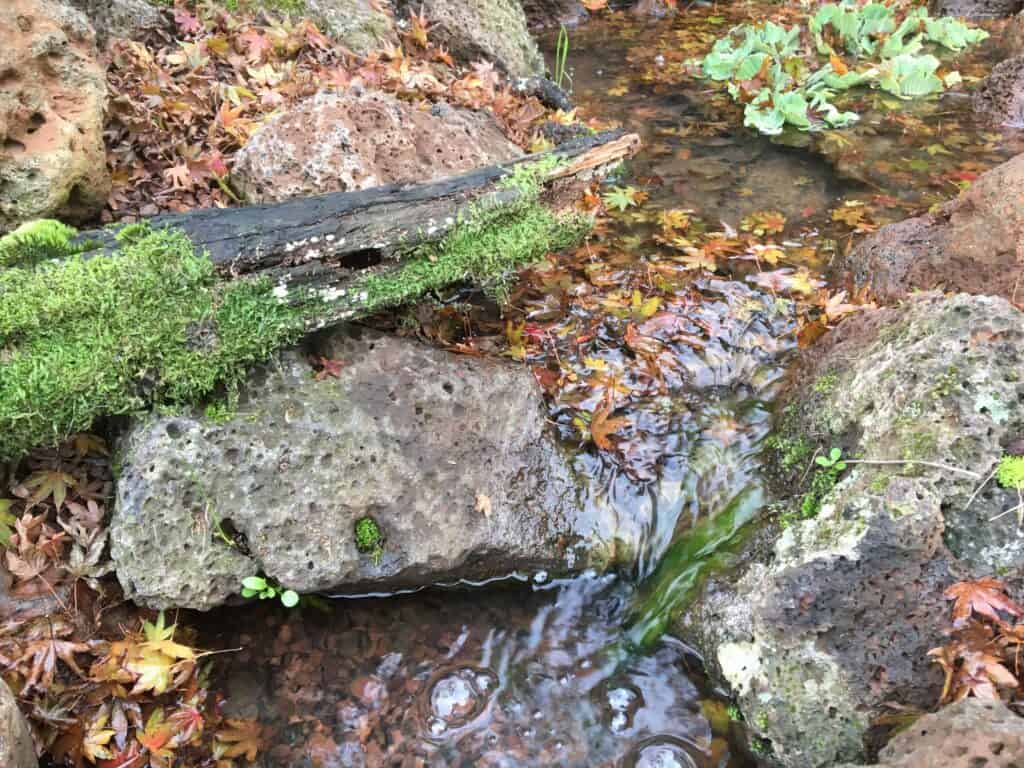
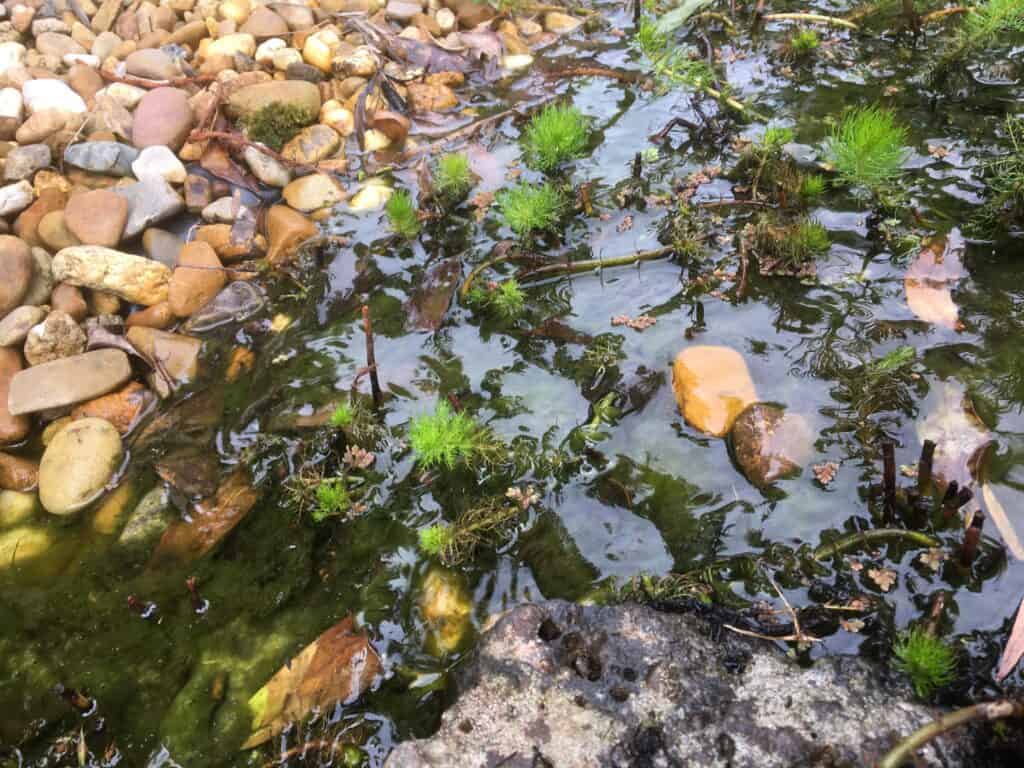
Bog filter size for a swim pond
For a swim or recreation pond the bog filter should be 25% or more.
If you create an up flow bog or wetland filter I believe 25% should be sufficient.
When I say “up flow” i mean that water is pushed up through the rocks, gravel and plant roots.
This is basically a scaled up version of what I created for my wine barrel pond.
I find up flow bog filters more efficient as the water is forced up through all the media that contains the good bacteria.
It is the bacteria that are responsible for 80% of the cleaning. The plants only take care of 20%.
There are other designs for bog filters for swim and recreation ponds. They do require a larger area for the actual bog. Generally 50-100% of the swimming area.
I do find these systems interesting. And the fact that they are powered by a simple air pump is just brilliant.
Best bog filter design practices
So like i just mentioned I am a big fan of up flow bog filters.
By forcing the water up through all the rocks, gravel and plant roots we are ensuring that every little bit of water is purified.
If we allow the water to flow down from the top it will take the path of least resistance. So what happens is we aren’t utilising all of the surface area.
Both systems work. I have just found that I get better results with a smaller footprint when using the up flow model.
Im also very big on providing an area for solid waste to accumulate.
Over time all the fine materials such as broken down leaves and fish poo form a sludge.

By allowing that stuff to settle in the filter where we have tons of bacteria it greatly reduces maintenance.
On my small bog filters i like to add a valve that i can open up to clear out the build up of sludge.
The larger in-ground bog filters its easier to incorporate a clean out chamber.
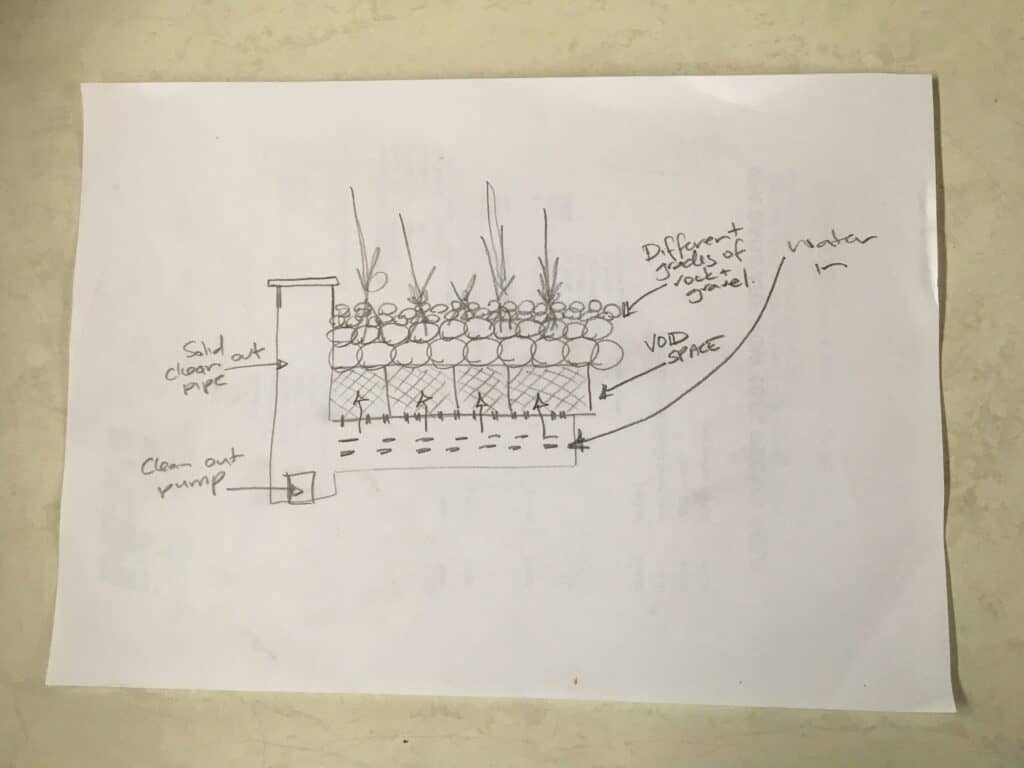
Depth of the bog filter
Depth is a funny issue. Some articles will tell you not to go any deeper than a foot (30cm).
My first experiment with a bog filter I used an old 220L (44Gal) olive oil barrel. The overall depth was at least 2ft.
It’s still working great!
One of the things I love about bog filters is that even if you don’t get them 100% right, you’ll still get fantastic results.
So don’t be overly concerned about the depth. What is more important is getting the water dispersed evenly through the entire bog.
So if you have a large shallow bog filter you need to create a system of pipes to disperse the water evenly throughout.
This is another area where the void space for the solids comes in handy. It allows water to pool in the bottom of the filter before rising evenly through the bog.
Selecting the right pump or flow rate
For me i want the water to take anywhere from 5-10 minutes to pass through the bog filter.
The closer to 10 the better.
You need to keep in mind that a bog is replicating a wetland. In wetlands the water passes through very slowly.
This allows the beneficial bacteria, enzymes and mice-organisms time to polish and cleanse the water.
Calculating the flow rate of a pump per minute is simply a matter of dividing the flow rate stated by 60.
The best way to set it up so you can get the flow just right is by utilising an energy efficient pump that will allow you to adjust the flow rate. Now you can dial in the flow to exactly what you want.
You can also oversize the pump and use a T-piece and a valve to discharge extra water over the surface of the bog filter. The remaining flow can discharge back into the pond as a jet or be added to a stream. It all depends on the pond design.
I like to incorporate a breather pipe to all my bog filters to prevent siphoning.
Sizing the rocks and gravel for the bog filter
On the small filters i tend to use 20mm pebble. I’m in Australia and we have a rock called scoria which is my go to in my small filters.
On the larger filters different layers is most effective.
The first course of rock directly above the solid settling zone are larger rocks. About the size of a rock melon.
Next we layer some medium sized rocks about the size of a fist.
Lastly we come in with small rock 20-25mm (1″)
The plants are planted directly into this top layer. Each layer is about 20cm (8″) high.
When planting remove all the soil. We want the plants to consume nutrients from the water itself.

Selecting the right plants
When selecting the plants for your bog filter (article on 40 awesome pond plants). Try and choose plants that are active at different times.
Obviously in areas with very cold winters this is impossible, so just focus on plants for the other seasons.
Many people have great success growing a mix of perennials that are suited to their local environment along side tropicals that they treat as an annual.
The tropicals grow really fast and strip loads of nutrients from the water during the hottest months.
Because they cannot survive the winter there is no worry about them becoming too invasive.
Speaking of invasive avoid anything that will take over. Diversity is the key.
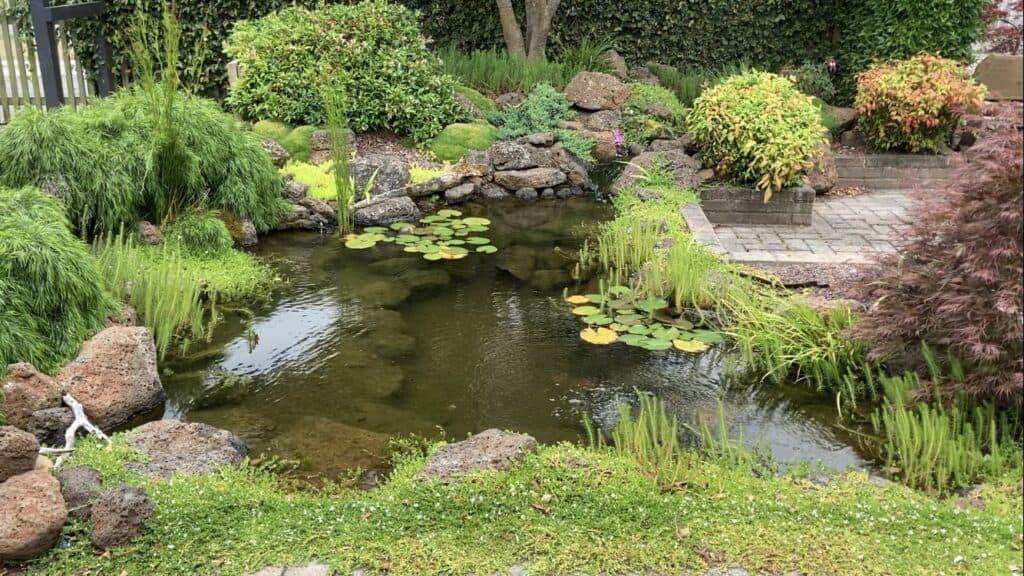
Join my free email list
If you would like to join my free email list click the button below.
I promise I won’t spam you, I’ll only send information I think can help you save money building and maintaining a pond.

